This September is being deemed “Go4Life Month,” via a campaign that encourages people age 50 and older to move more and stay active for better health with advancing age, according to a release from the National Institutes of Health (NIH).
Per the release, during Go4Life Month—themed “Be Active Every Day”—more than 100 federal, state, and local partners will come together to increase awareness and sponsor activities to encourage people to participate in exercise and activities that they enjoy.
The National Institute on Aging (NIA) reportedly hopes that the community focus of Go4Life Month will help expand the campaign’s reach so that increasing numbers of older adults can reap the benefits of exercise and physical activity.
The release explains that Go4Life is a collaboration between the White House Conference on Aging, The NIA, and the NIH, and it is based on research showing that exercise can help prevent many of the chronic conditions and disability associated with aging.
Despite the growing list of benefits of exercise for people of all ages, US adults tend to become less active as they age. Therefore, Go4Life helps by providing information and motivational tools to help older adults increase their physical activity and by working with local and national organizations to provide an environment that supports these efforts, the release continues.
“It’s never too late for exercise to have a positive effect on your health,” says NIA Director Richard J. Hodes, MD, in the release.
“We know that exercise can reduce the risk of heart disease, obesity, stroke, diabetes, and other chronic conditions. One recent study found that even sedentary people in their 70s and 80s improved mobility and reduced risk of disability through a regular program of structured physical activity,” he continues in the release.
Hodes notes in the release that the establishment of Go4Life Month will help draw attention to the critical importance of exercise with age and the resources that can be provided to support adults who want to do more.
[Source: National Institutes of Health]





